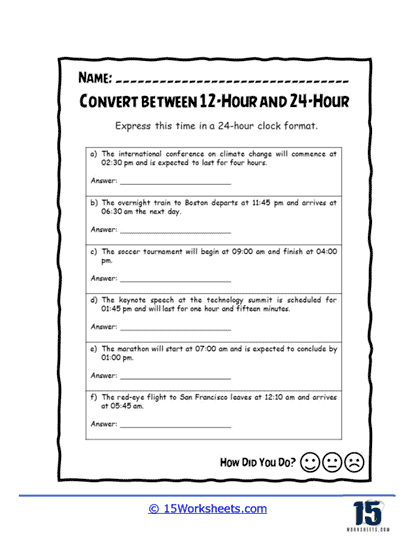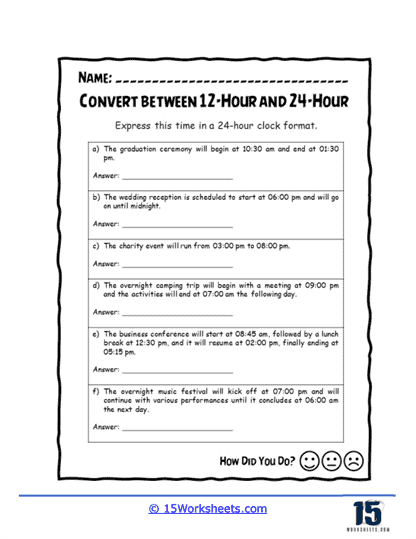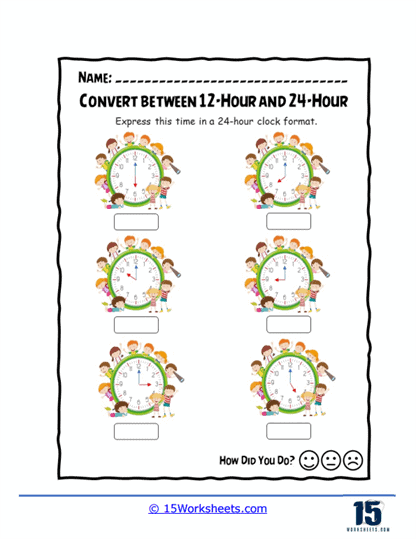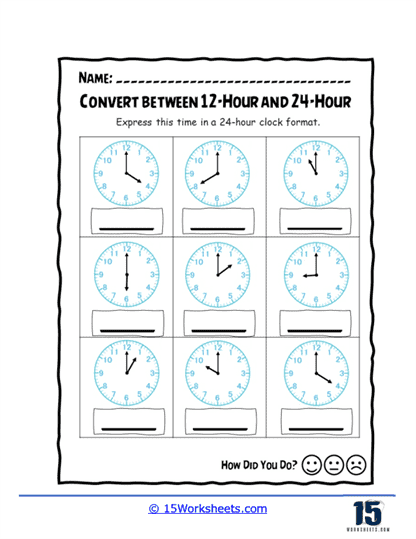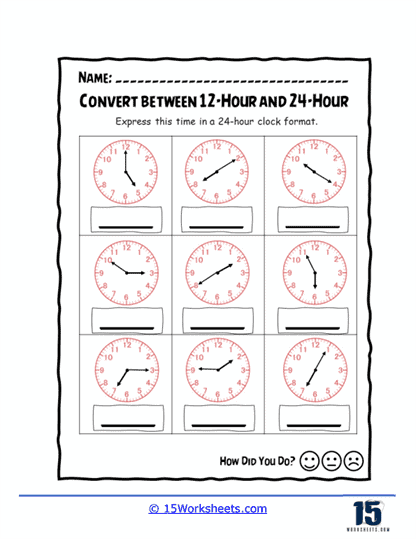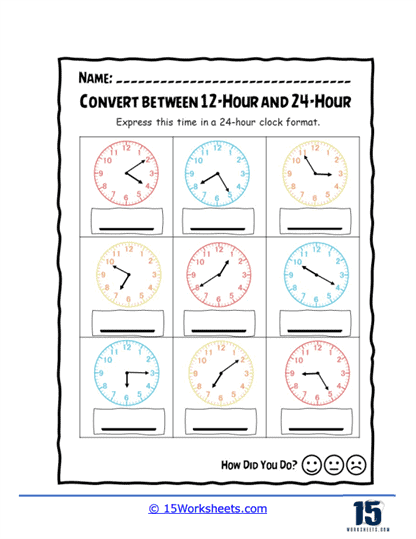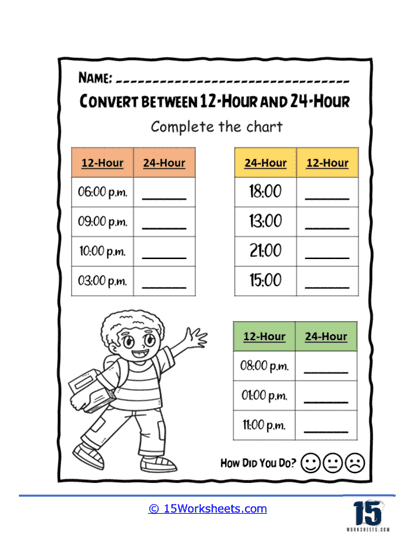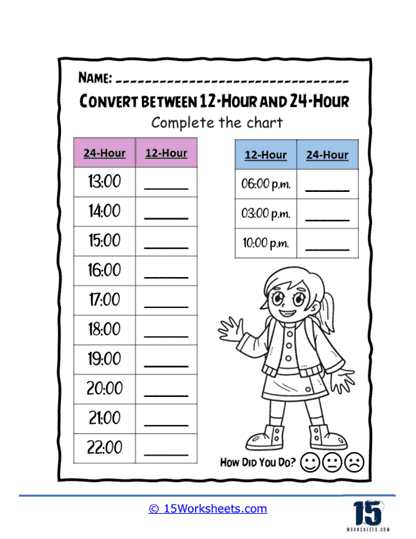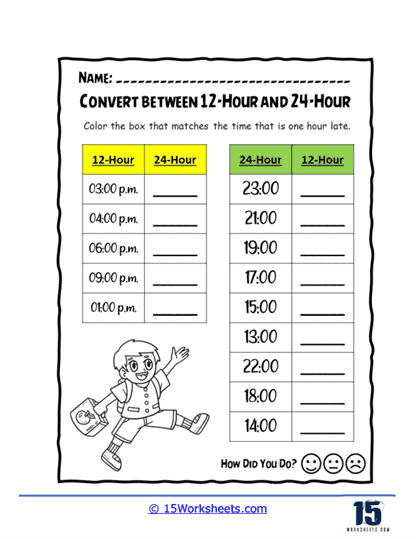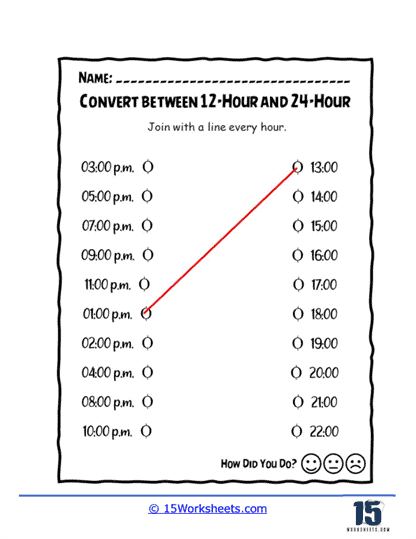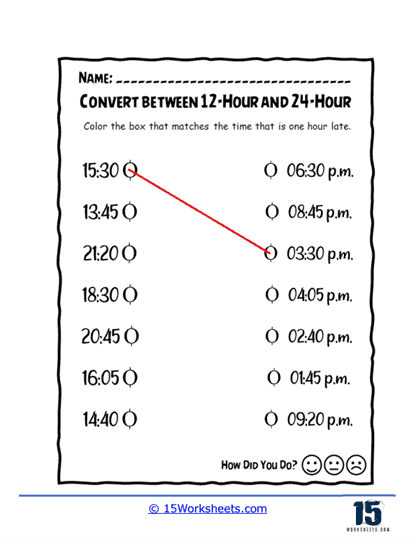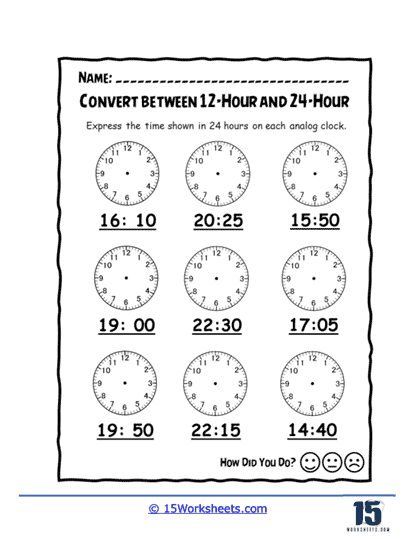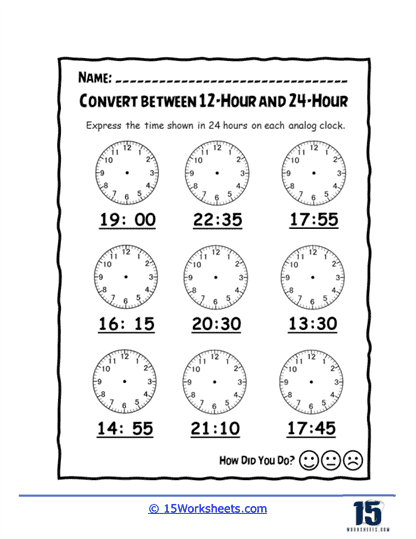Convert Between 12-Hour and 24-Hour Worksheets
About These 15 Worksheets
These worksheets will help students understand and practice the conversion of time between the two most commonly used time formats. The 12-hour clock, which divides the day into two periods of 12 hours each (AM and PM), is widely used in everyday life in many countries. On the other hand, the 24-hour clock, also known as military time, runs from 00:00 to 23:59 and is used in many professional and international contexts. These worksheets provide various exercises to help students master this essential skill, making them capable of interpreting and converting times accurately in both formats.
The Importance of Time Conversion Skills
Time conversion skills are fundamental for students because they play a crucial role in time management and daily scheduling. Understanding both time formats and knowing how to convert between them ensures that students can interpret timetables, schedules, and digital clocks accurately. This skill is especially important as students encounter various time formats in different contexts, such as in travel schedules, international communication, and professional environments. Moreover, mastering time conversion enhances students’ overall numeracy and cognitive skills, contributing to their academic and personal development.
A Look At Individual Worksheets
Foundational Time Conversion
The adventure commences with worksheets like Hourglass Handoff, Twenty-Four Switch, and Clock Converter. These exercises lay the groundwork, introducing students to the fundamental principles of converting between 12-hour and 24-hour formats. By engaging with these tasks, learners become adept at recognizing that 3:00 PM translates to 15:00 in 24-hour time, and vice versa. It’s the equivalent of learning the secret handshake to the club of time aficionados.
Interpreting and Translating Schedules
Progressing deeper, worksheets such as Schedule Shift, Event Time Translator, and Hourly Traveler immerse students in real-world scenarios. These exercises challenge learners to apply their conversion skills to practical situations, like deciphering train timetables or international meeting schedules. It’s like being handed the keys to a time machine, enabling one to traverse time zones and schedules with ease.
Puzzles and Challenges
For those who relish a good brain teaser, Time-Switch Puzzle, AM/PM Puzzle, and Time Switch Spectacular offer a medley of matching games and riddles. These worksheets transform the learning process into an engaging puzzle, where each solved problem is a piece fitting perfectly into the larger picture of time mastery. It’s akin to being a detective, unraveling the mysteries of time with each clue.
Advanced Time Manipulation
Elevating the challenge, Timepiece Transformation, Time Switch Master, and Conversion Wizardry delve into complex scenarios involving elapsed time and intricate scheduling. These worksheets are the final boss battles of the time conversion world, demanding precision and critical thinking. Conquering them bestows the title of Time Conversion Connoisseur upon the student.
Specialized Time Contexts
Lastly, Hour Handoff, Military Moments, and Clock Conversion focus on specific contexts where 24-hour time is prevalent, such as military operations or international travel. These worksheets ensure that students are not just fluent in time conversion but also culturally and contextually aware, ready to apply their skills wherever the hands of the clock may point.
Real World Applications
Understanding how to convert between 12-hour and 24-hour time formats is highly useful in the real world for various reasons, primarily due to the widespread use of both formats in different contexts and regions. Mastery of this skill enhances communication, scheduling, and planning across multiple scenarios.
Many countries and industries use the 24-hour time format, also known as military time, for precision and to avoid ambiguity. For instance, transportation schedules for airlines, trains, and buses often use the 24-hour format to clearly indicate times and prevent misunderstandings. Knowing how to convert between formats ensures travelers can accurately interpret departure and arrival times, reducing the risk of missing connections or flights.
In professional settings, the ability to switch between time formats is crucial for effective communication, especially in global businesses. Many international companies and military operations standardize on the 24-hour clock to streamline operations and avoid confusion caused by time zone differences and the AM/PM designation. Being able to convert times allows employees to coordinate meetings and deadlines accurately with colleagues across different regions, ensuring seamless collaboration.
Healthcare is another field where understanding both time formats is essential. Medical professionals often use the 24-hour clock to record and communicate the timing of medication administrations, treatments, and shift changes. Accurate timekeeping is critical in this context to maintain patient safety and ensure that care is provided at the correct times.
Personal organization benefits from this skill. Many digital devices, such as smartphones, computers, and smart home systems, allow users to select their preferred time format. Being adept at converting between the two formats means that individuals can efficiently manage their schedules, set alarms, and program devices without confusion, regardless of the default settings.
Example Problem – Samantha has a school project due at 2:45 PM. She wants to convert this time into the 24-hour format. What time is 2:45 PM in the 24-hour format?
Step-by-Step Solution
1. Understand the Conversion Rule
– For PM times in the 12-hour format (from 1:00 PM to 11:59 PM), you need to add 12 to the hour part to convert it to the 24-hour format.
– For AM times (from 12:00 AM to 11:59 AM), the time remains the same except for 12:00 AM which becomes 00:00 in the 24-hour format.
2. Identify the Time to Convert
The given time is 2:45 PM.
3. Separate the Hours and Minutes
Hours: 2
Minutes: 45
4. Convert the Hours from PM to 24-hour Format
Since it is PM, add 12 to the hour part: 2 + 12 = 14.
5. Combine the Converted Hours and Minutes
The converted time is 14:45.
6. Answer – 2:45 PM in the 12-hour format is 14:45 in the 24-hour format.


